Retail Management: Analyzing Retail in Australia and the UK
VerifiedAdded on 2021/01/01
|13
|3740
|318
Report
AI Summary
This report provides a comparative analysis of the retail industries in Australia and the United Kingdom. It begins by outlining the differences in the structure of the retail markets in both countries, detailing the number of businesses, employment figures, and the impact of online retailing. The report then estimates the potential size and profitability of the retail industries in Australia and the UK, citing sales figures, growth rates, and the performance of major retail companies. It also identifies potential problems facing the retail industries in both countries, such as rising operational costs, changing consumer trends, and the impact of e-commerce. Finally, the report considers the cultural aspects that impact retailing in Australia and the UK, offering a comprehensive overview of the retail landscape in both nations. The report concludes with recommendations for navigating the challenges and opportunities in the retail sector.
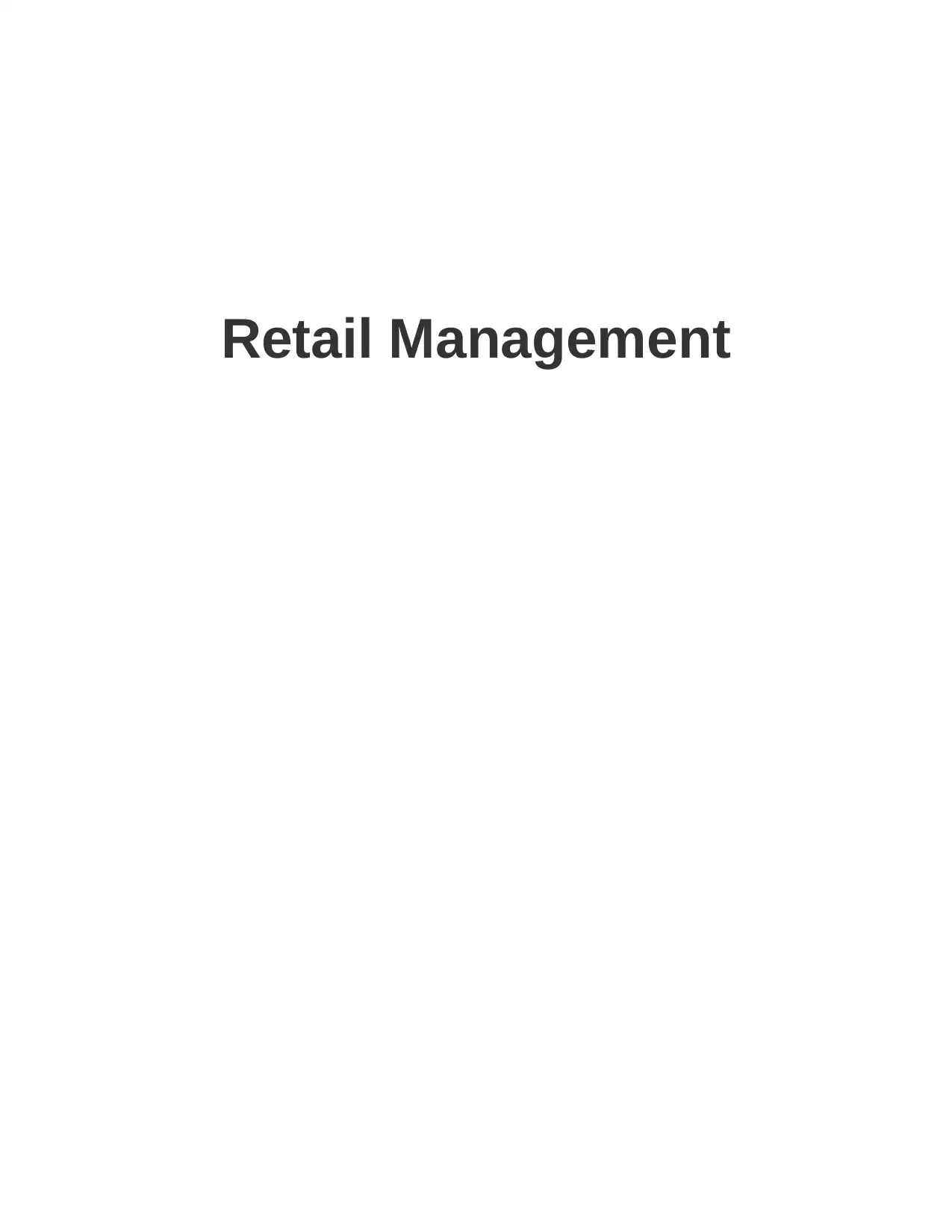
Retail Management
Paraphrase This Document
Need a fresh take? Get an instant paraphrase of this document with our AI Paraphraser
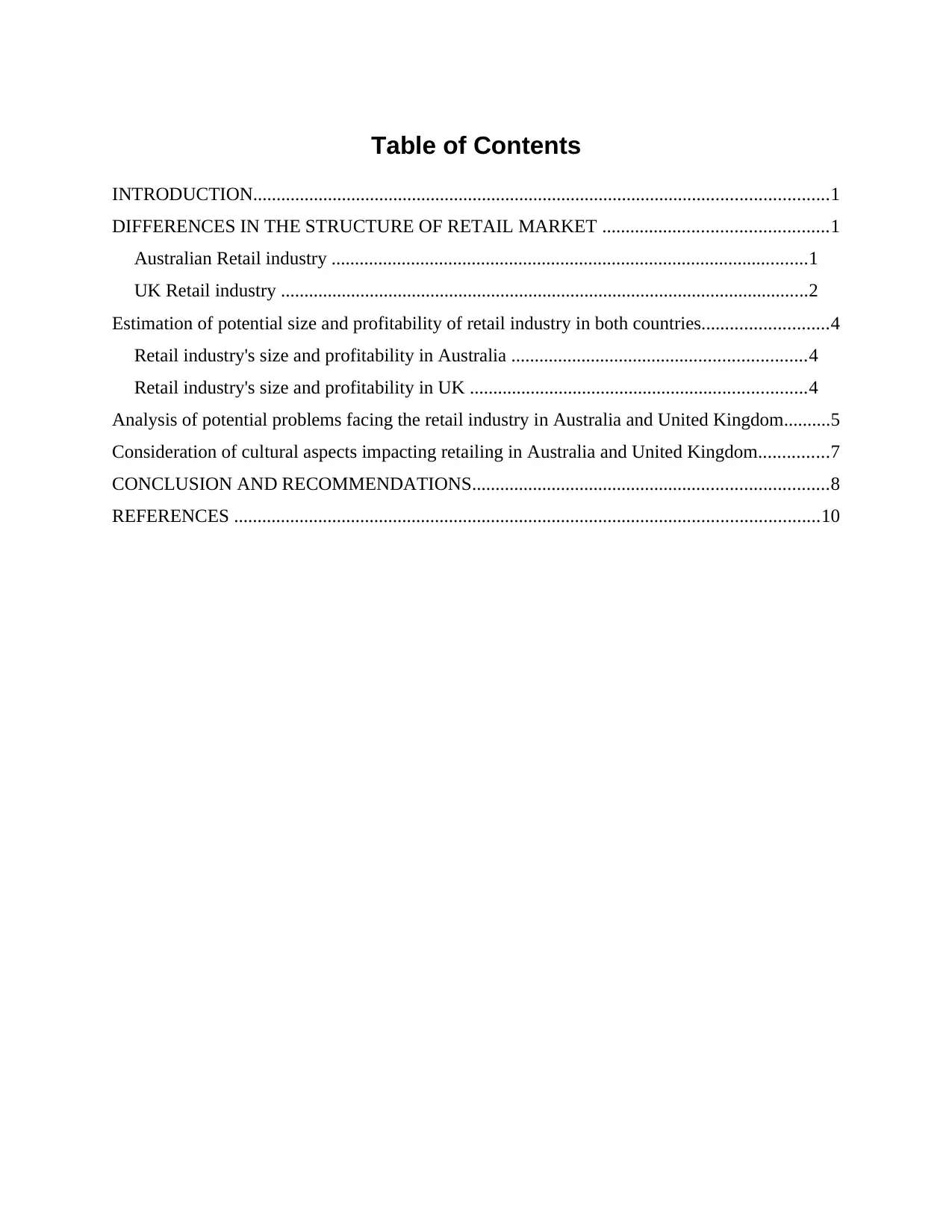
Table of Contents
INTRODUCTION...........................................................................................................................1
DIFFERENCES IN THE STRUCTURE OF RETAIL MARKET ................................................1
Australian Retail industry ......................................................................................................1
UK Retail industry .................................................................................................................2
Estimation of potential size and profitability of retail industry in both countries...........................4
Retail industry's size and profitability in Australia ...............................................................4
Retail industry's size and profitability in UK ........................................................................4
Analysis of potential problems facing the retail industry in Australia and United Kingdom..........5
Consideration of cultural aspects impacting retailing in Australia and United Kingdom...............7
CONCLUSION AND RECOMMENDATIONS............................................................................8
REFERENCES .............................................................................................................................10
INTRODUCTION...........................................................................................................................1
DIFFERENCES IN THE STRUCTURE OF RETAIL MARKET ................................................1
Australian Retail industry ......................................................................................................1
UK Retail industry .................................................................................................................2
Estimation of potential size and profitability of retail industry in both countries...........................4
Retail industry's size and profitability in Australia ...............................................................4
Retail industry's size and profitability in UK ........................................................................4
Analysis of potential problems facing the retail industry in Australia and United Kingdom..........5
Consideration of cultural aspects impacting retailing in Australia and United Kingdom...............7
CONCLUSION AND RECOMMENDATIONS............................................................................8
REFERENCES .............................................................................................................................10
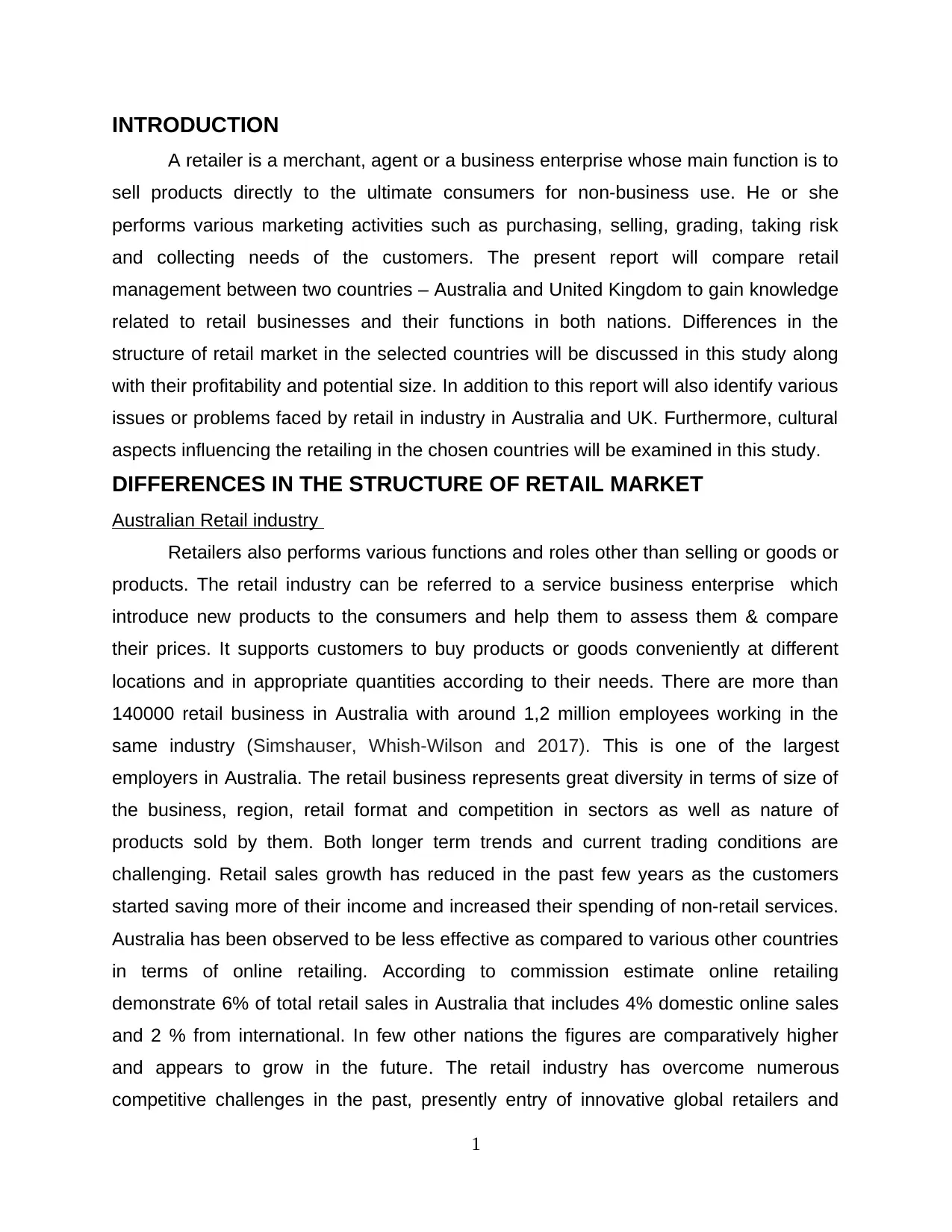
INTRODUCTION
A retailer is a merchant, agent or a business enterprise whose main function is to
sell products directly to the ultimate consumers for non-business use. He or she
performs various marketing activities such as purchasing, selling, grading, taking risk
and collecting needs of the customers. The present report will compare retail
management between two countries – Australia and United Kingdom to gain knowledge
related to retail businesses and their functions in both nations. Differences in the
structure of retail market in the selected countries will be discussed in this study along
with their profitability and potential size. In addition to this report will also identify various
issues or problems faced by retail in industry in Australia and UK. Furthermore, cultural
aspects influencing the retailing in the chosen countries will be examined in this study.
DIFFERENCES IN THE STRUCTURE OF RETAIL MARKET
Australian Retail industry
Retailers also performs various functions and roles other than selling or goods or
products. The retail industry can be referred to a service business enterprise which
introduce new products to the consumers and help them to assess them & compare
their prices. It supports customers to buy products or goods conveniently at different
locations and in appropriate quantities according to their needs. There are more than
140000 retail business in Australia with around 1,2 million employees working in the
same industry (Simshauser, Whish-Wilson and 2017). This is one of the largest
employers in Australia. The retail business represents great diversity in terms of size of
the business, region, retail format and competition in sectors as well as nature of
products sold by them. Both longer term trends and current trading conditions are
challenging. Retail sales growth has reduced in the past few years as the customers
started saving more of their income and increased their spending of non-retail services.
Australia has been observed to be less effective as compared to various other countries
in terms of online retailing. According to commission estimate online retailing
demonstrate 6% of total retail sales in Australia that includes 4% domestic online sales
and 2 % from international. In few other nations the figures are comparatively higher
and appears to grow in the future. The retail industry has overcome numerous
competitive challenges in the past, presently entry of innovative global retailers and
1
A retailer is a merchant, agent or a business enterprise whose main function is to
sell products directly to the ultimate consumers for non-business use. He or she
performs various marketing activities such as purchasing, selling, grading, taking risk
and collecting needs of the customers. The present report will compare retail
management between two countries – Australia and United Kingdom to gain knowledge
related to retail businesses and their functions in both nations. Differences in the
structure of retail market in the selected countries will be discussed in this study along
with their profitability and potential size. In addition to this report will also identify various
issues or problems faced by retail in industry in Australia and UK. Furthermore, cultural
aspects influencing the retailing in the chosen countries will be examined in this study.
DIFFERENCES IN THE STRUCTURE OF RETAIL MARKET
Australian Retail industry
Retailers also performs various functions and roles other than selling or goods or
products. The retail industry can be referred to a service business enterprise which
introduce new products to the consumers and help them to assess them & compare
their prices. It supports customers to buy products or goods conveniently at different
locations and in appropriate quantities according to their needs. There are more than
140000 retail business in Australia with around 1,2 million employees working in the
same industry (Simshauser, Whish-Wilson and 2017). This is one of the largest
employers in Australia. The retail business represents great diversity in terms of size of
the business, region, retail format and competition in sectors as well as nature of
products sold by them. Both longer term trends and current trading conditions are
challenging. Retail sales growth has reduced in the past few years as the customers
started saving more of their income and increased their spending of non-retail services.
Australia has been observed to be less effective as compared to various other countries
in terms of online retailing. According to commission estimate online retailing
demonstrate 6% of total retail sales in Australia that includes 4% domestic online sales
and 2 % from international. In few other nations the figures are comparatively higher
and appears to grow in the future. The retail industry has overcome numerous
competitive challenges in the past, presently entry of innovative global retailers and
1
⊘ This is a preview!⊘
Do you want full access?
Subscribe today to unlock all pages.

Trusted by 1+ million students worldwide
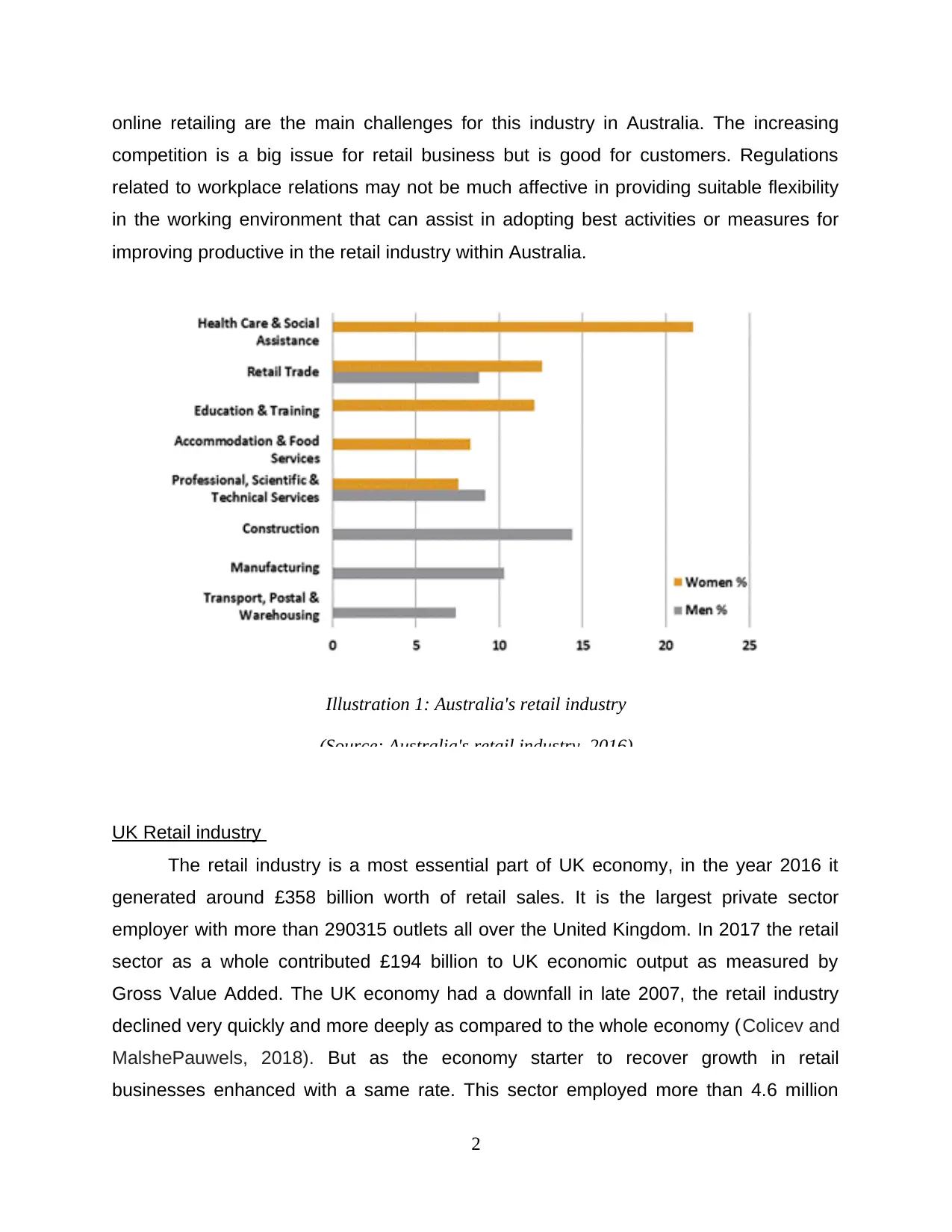
online retailing are the main challenges for this industry in Australia. The increasing
competition is a big issue for retail business but is good for customers. Regulations
related to workplace relations may not be much affective in providing suitable flexibility
in the working environment that can assist in adopting best activities or measures for
improving productive in the retail industry within Australia.
UK Retail industry
The retail industry is a most essential part of UK economy, in the year 2016 it
generated around £358 billion worth of retail sales. It is the largest private sector
employer with more than 290315 outlets all over the United Kingdom. In 2017 the retail
sector as a whole contributed £194 billion to UK economic output as measured by
Gross Value Added. The UK economy had a downfall in late 2007, the retail industry
declined very quickly and more deeply as compared to the whole economy (Colicev and
MalshePauwels, 2018). But as the economy starter to recover growth in retail
businesses enhanced with a same rate. This sector employed more than 4.6 million
2
Illustration 1: Australia's retail industry
(Source: Australia's retail industry, 2016)
competition is a big issue for retail business but is good for customers. Regulations
related to workplace relations may not be much affective in providing suitable flexibility
in the working environment that can assist in adopting best activities or measures for
improving productive in the retail industry within Australia.
UK Retail industry
The retail industry is a most essential part of UK economy, in the year 2016 it
generated around £358 billion worth of retail sales. It is the largest private sector
employer with more than 290315 outlets all over the United Kingdom. In 2017 the retail
sector as a whole contributed £194 billion to UK economic output as measured by
Gross Value Added. The UK economy had a downfall in late 2007, the retail industry
declined very quickly and more deeply as compared to the whole economy (Colicev and
MalshePauwels, 2018). But as the economy starter to recover growth in retail
businesses enhanced with a same rate. This sector employed more than 4.6 million
2
Illustration 1: Australia's retail industry
(Source: Australia's retail industry, 2016)
Paraphrase This Document
Need a fresh take? Get an instant paraphrase of this document with our AI Paraphraser
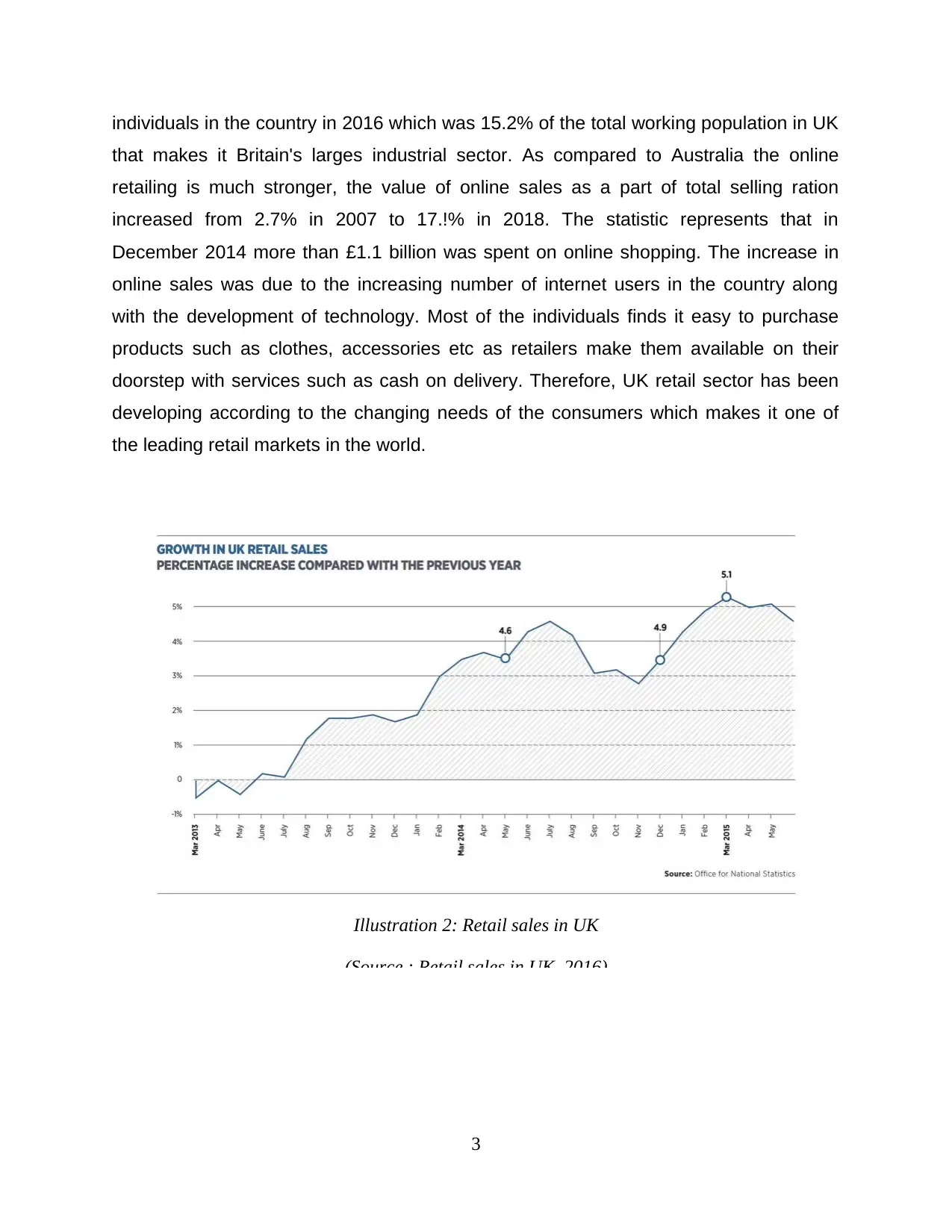
individuals in the country in 2016 which was 15.2% of the total working population in UK
that makes it Britain's larges industrial sector. As compared to Australia the online
retailing is much stronger, the value of online sales as a part of total selling ration
increased from 2.7% in 2007 to 17.!% in 2018. The statistic represents that in
December 2014 more than £1.1 billion was spent on online shopping. The increase in
online sales was due to the increasing number of internet users in the country along
with the development of technology. Most of the individuals finds it easy to purchase
products such as clothes, accessories etc as retailers make them available on their
doorstep with services such as cash on delivery. Therefore, UK retail sector has been
developing according to the changing needs of the consumers which makes it one of
the leading retail markets in the world.
3
Illustration 2: Retail sales in UK
(Source : Retail sales in UK, 2016)
that makes it Britain's larges industrial sector. As compared to Australia the online
retailing is much stronger, the value of online sales as a part of total selling ration
increased from 2.7% in 2007 to 17.!% in 2018. The statistic represents that in
December 2014 more than £1.1 billion was spent on online shopping. The increase in
online sales was due to the increasing number of internet users in the country along
with the development of technology. Most of the individuals finds it easy to purchase
products such as clothes, accessories etc as retailers make them available on their
doorstep with services such as cash on delivery. Therefore, UK retail sector has been
developing according to the changing needs of the consumers which makes it one of
the leading retail markets in the world.
3
Illustration 2: Retail sales in UK
(Source : Retail sales in UK, 2016)
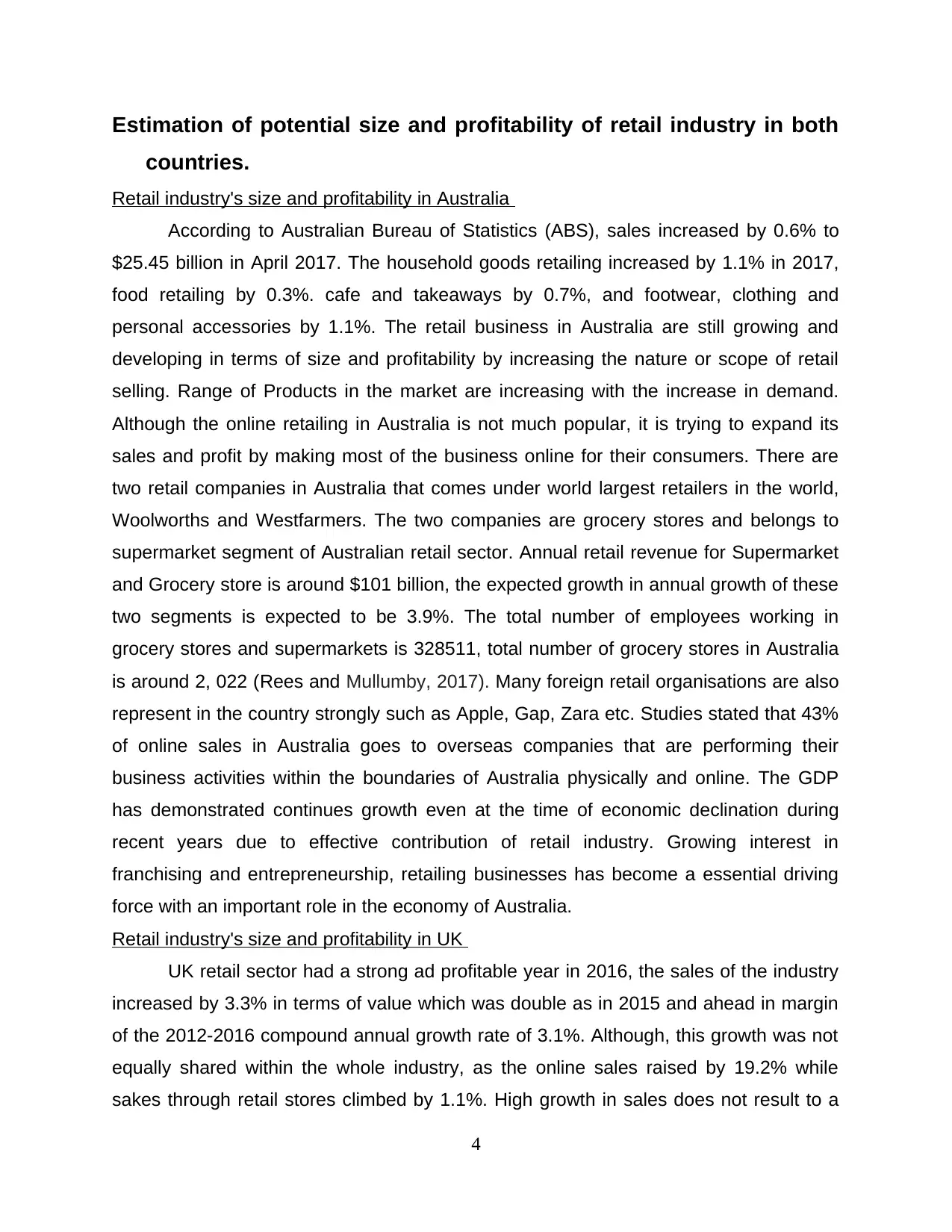
Estimation of potential size and profitability of retail industry in both
countries.
Retail industry's size and profitability in Australia
According to Australian Bureau of Statistics (ABS), sales increased by 0.6% to
$25.45 billion in April 2017. The household goods retailing increased by 1.1% in 2017,
food retailing by 0.3%. cafe and takeaways by 0.7%, and footwear, clothing and
personal accessories by 1.1%. The retail business in Australia are still growing and
developing in terms of size and profitability by increasing the nature or scope of retail
selling. Range of Products in the market are increasing with the increase in demand.
Although the online retailing in Australia is not much popular, it is trying to expand its
sales and profit by making most of the business online for their consumers. There are
two retail companies in Australia that comes under world largest retailers in the world,
Woolworths and Westfarmers. The two companies are grocery stores and belongs to
supermarket segment of Australian retail sector. Annual retail revenue for Supermarket
and Grocery store is around $101 billion, the expected growth in annual growth of these
two segments is expected to be 3.9%. The total number of employees working in
grocery stores and supermarkets is 328511, total number of grocery stores in Australia
is around 2, 022 (Rees and Mullumby, 2017). Many foreign retail organisations are also
represent in the country strongly such as Apple, Gap, Zara etc. Studies stated that 43%
of online sales in Australia goes to overseas companies that are performing their
business activities within the boundaries of Australia physically and online. The GDP
has demonstrated continues growth even at the time of economic declination during
recent years due to effective contribution of retail industry. Growing interest in
franchising and entrepreneurship, retailing businesses has become a essential driving
force with an important role in the economy of Australia.
Retail industry's size and profitability in UK
UK retail sector had a strong ad profitable year in 2016, the sales of the industry
increased by 3.3% in terms of value which was double as in 2015 and ahead in margin
of the 2012-2016 compound annual growth rate of 3.1%. Although, this growth was not
equally shared within the whole industry, as the online sales raised by 19.2% while
sakes through retail stores climbed by 1.1%. High growth in sales does not result to a
4
countries.
Retail industry's size and profitability in Australia
According to Australian Bureau of Statistics (ABS), sales increased by 0.6% to
$25.45 billion in April 2017. The household goods retailing increased by 1.1% in 2017,
food retailing by 0.3%. cafe and takeaways by 0.7%, and footwear, clothing and
personal accessories by 1.1%. The retail business in Australia are still growing and
developing in terms of size and profitability by increasing the nature or scope of retail
selling. Range of Products in the market are increasing with the increase in demand.
Although the online retailing in Australia is not much popular, it is trying to expand its
sales and profit by making most of the business online for their consumers. There are
two retail companies in Australia that comes under world largest retailers in the world,
Woolworths and Westfarmers. The two companies are grocery stores and belongs to
supermarket segment of Australian retail sector. Annual retail revenue for Supermarket
and Grocery store is around $101 billion, the expected growth in annual growth of these
two segments is expected to be 3.9%. The total number of employees working in
grocery stores and supermarkets is 328511, total number of grocery stores in Australia
is around 2, 022 (Rees and Mullumby, 2017). Many foreign retail organisations are also
represent in the country strongly such as Apple, Gap, Zara etc. Studies stated that 43%
of online sales in Australia goes to overseas companies that are performing their
business activities within the boundaries of Australia physically and online. The GDP
has demonstrated continues growth even at the time of economic declination during
recent years due to effective contribution of retail industry. Growing interest in
franchising and entrepreneurship, retailing businesses has become a essential driving
force with an important role in the economy of Australia.
Retail industry's size and profitability in UK
UK retail sector had a strong ad profitable year in 2016, the sales of the industry
increased by 3.3% in terms of value which was double as in 2015 and ahead in margin
of the 2012-2016 compound annual growth rate of 3.1%. Although, this growth was not
equally shared within the whole industry, as the online sales raised by 19.2% while
sakes through retail stores climbed by 1.1%. High growth in sales does not result to a
4
⊘ This is a preview!⊘
Do you want full access?
Subscribe today to unlock all pages.

Trusted by 1+ million students worldwide
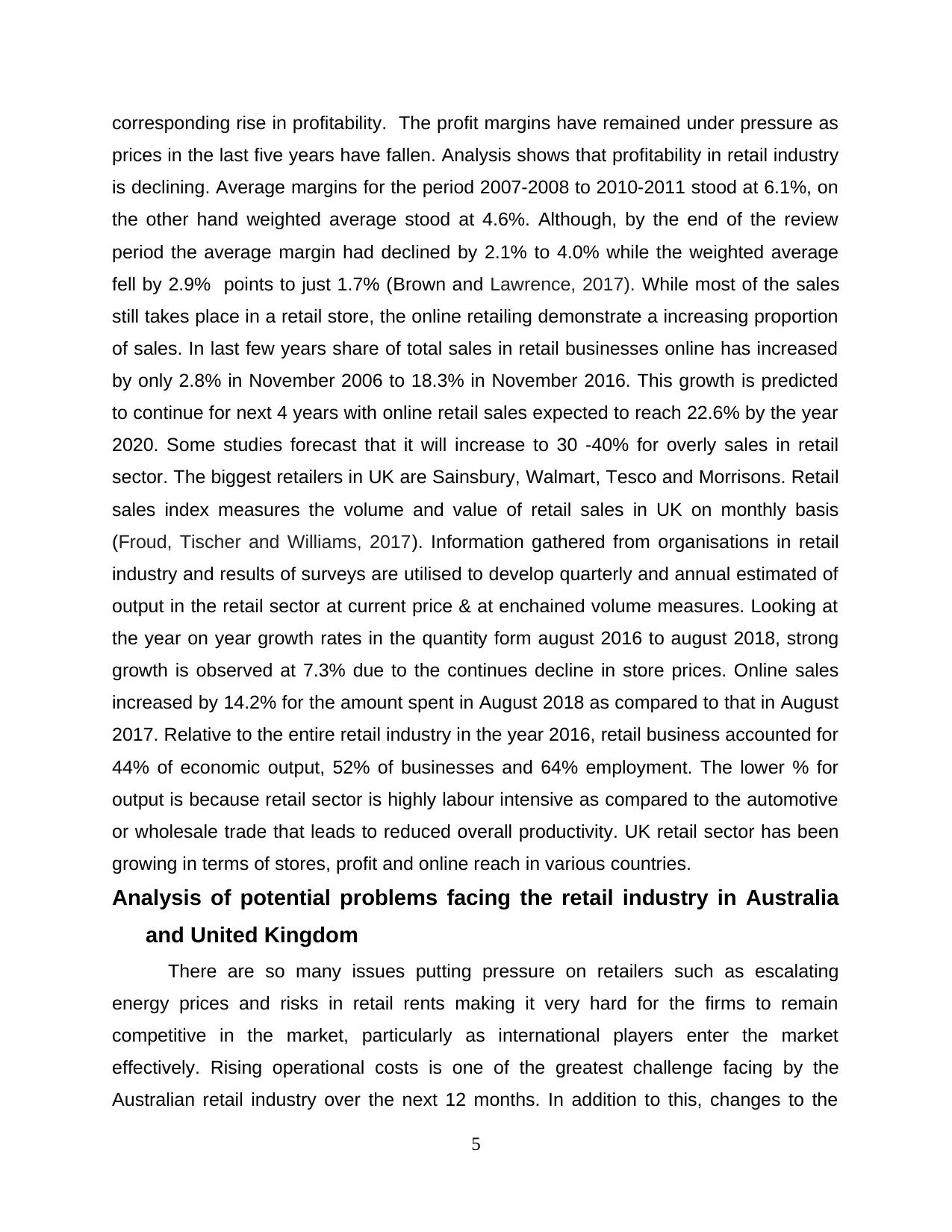
corresponding rise in profitability. The profit margins have remained under pressure as
prices in the last five years have fallen. Analysis shows that profitability in retail industry
is declining. Average margins for the period 2007-2008 to 2010-2011 stood at 6.1%, on
the other hand weighted average stood at 4.6%. Although, by the end of the review
period the average margin had declined by 2.1% to 4.0% while the weighted average
fell by 2.9% points to just 1.7% (Brown and Lawrence, 2017). While most of the sales
still takes place in a retail store, the online retailing demonstrate a increasing proportion
of sales. In last few years share of total sales in retail businesses online has increased
by only 2.8% in November 2006 to 18.3% in November 2016. This growth is predicted
to continue for next 4 years with online retail sales expected to reach 22.6% by the year
2020. Some studies forecast that it will increase to 30 -40% for overly sales in retail
sector. The biggest retailers in UK are Sainsbury, Walmart, Tesco and Morrisons. Retail
sales index measures the volume and value of retail sales in UK on monthly basis
(Froud, Tischer and Williams, 2017). Information gathered from organisations in retail
industry and results of surveys are utilised to develop quarterly and annual estimated of
output in the retail sector at current price & at enchained volume measures. Looking at
the year on year growth rates in the quantity form august 2016 to august 2018, strong
growth is observed at 7.3% due to the continues decline in store prices. Online sales
increased by 14.2% for the amount spent in August 2018 as compared to that in August
2017. Relative to the entire retail industry in the year 2016, retail business accounted for
44% of economic output, 52% of businesses and 64% employment. The lower % for
output is because retail sector is highly labour intensive as compared to the automotive
or wholesale trade that leads to reduced overall productivity. UK retail sector has been
growing in terms of stores, profit and online reach in various countries.
Analysis of potential problems facing the retail industry in Australia
and United Kingdom
There are so many issues putting pressure on retailers such as escalating
energy prices and risks in retail rents making it very hard for the firms to remain
competitive in the market, particularly as international players enter the market
effectively. Rising operational costs is one of the greatest challenge facing by the
Australian retail industry over the next 12 months. In addition to this, changes to the
5
prices in the last five years have fallen. Analysis shows that profitability in retail industry
is declining. Average margins for the period 2007-2008 to 2010-2011 stood at 6.1%, on
the other hand weighted average stood at 4.6%. Although, by the end of the review
period the average margin had declined by 2.1% to 4.0% while the weighted average
fell by 2.9% points to just 1.7% (Brown and Lawrence, 2017). While most of the sales
still takes place in a retail store, the online retailing demonstrate a increasing proportion
of sales. In last few years share of total sales in retail businesses online has increased
by only 2.8% in November 2006 to 18.3% in November 2016. This growth is predicted
to continue for next 4 years with online retail sales expected to reach 22.6% by the year
2020. Some studies forecast that it will increase to 30 -40% for overly sales in retail
sector. The biggest retailers in UK are Sainsbury, Walmart, Tesco and Morrisons. Retail
sales index measures the volume and value of retail sales in UK on monthly basis
(Froud, Tischer and Williams, 2017). Information gathered from organisations in retail
industry and results of surveys are utilised to develop quarterly and annual estimated of
output in the retail sector at current price & at enchained volume measures. Looking at
the year on year growth rates in the quantity form august 2016 to august 2018, strong
growth is observed at 7.3% due to the continues decline in store prices. Online sales
increased by 14.2% for the amount spent in August 2018 as compared to that in August
2017. Relative to the entire retail industry in the year 2016, retail business accounted for
44% of economic output, 52% of businesses and 64% employment. The lower % for
output is because retail sector is highly labour intensive as compared to the automotive
or wholesale trade that leads to reduced overall productivity. UK retail sector has been
growing in terms of stores, profit and online reach in various countries.
Analysis of potential problems facing the retail industry in Australia
and United Kingdom
There are so many issues putting pressure on retailers such as escalating
energy prices and risks in retail rents making it very hard for the firms to remain
competitive in the market, particularly as international players enter the market
effectively. Rising operational costs is one of the greatest challenge facing by the
Australian retail industry over the next 12 months. In addition to this, changes to the
5
Paraphrase This Document
Need a fresh take? Get an instant paraphrase of this document with our AI Paraphraser
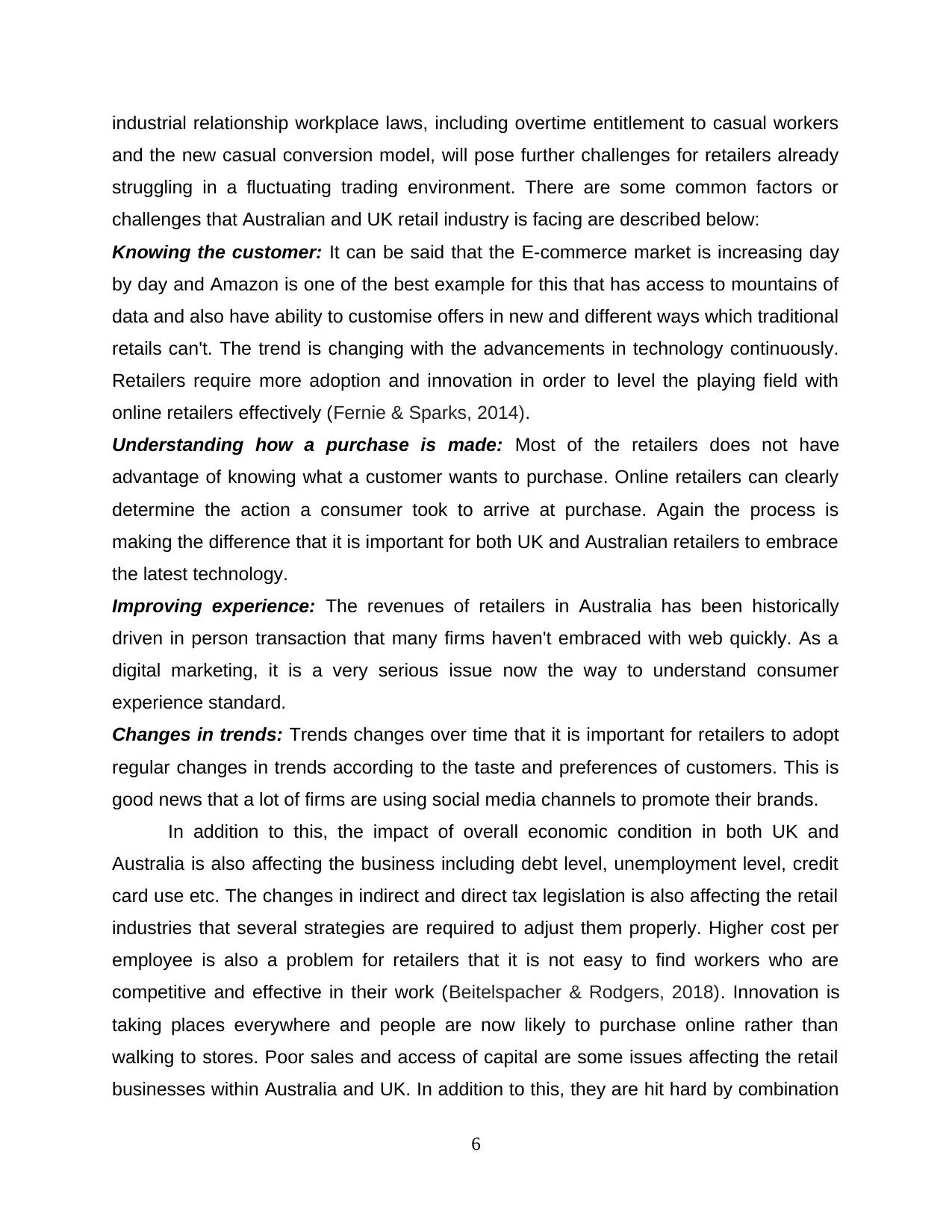
industrial relationship workplace laws, including overtime entitlement to casual workers
and the new casual conversion model, will pose further challenges for retailers already
struggling in a fluctuating trading environment. There are some common factors or
challenges that Australian and UK retail industry is facing are described below:
Knowing the customer: It can be said that the E-commerce market is increasing day
by day and Amazon is one of the best example for this that has access to mountains of
data and also have ability to customise offers in new and different ways which traditional
retails can't. The trend is changing with the advancements in technology continuously.
Retailers require more adoption and innovation in order to level the playing field with
online retailers effectively (Fernie & Sparks, 2014).
Understanding how a purchase is made: Most of the retailers does not have
advantage of knowing what a customer wants to purchase. Online retailers can clearly
determine the action a consumer took to arrive at purchase. Again the process is
making the difference that it is important for both UK and Australian retailers to embrace
the latest technology.
Improving experience: The revenues of retailers in Australia has been historically
driven in person transaction that many firms haven't embraced with web quickly. As a
digital marketing, it is a very serious issue now the way to understand consumer
experience standard.
Changes in trends: Trends changes over time that it is important for retailers to adopt
regular changes in trends according to the taste and preferences of customers. This is
good news that a lot of firms are using social media channels to promote their brands.
In addition to this, the impact of overall economic condition in both UK and
Australia is also affecting the business including debt level, unemployment level, credit
card use etc. The changes in indirect and direct tax legislation is also affecting the retail
industries that several strategies are required to adjust them properly. Higher cost per
employee is also a problem for retailers that it is not easy to find workers who are
competitive and effective in their work (Beitelspacher & Rodgers, 2018). Innovation is
taking places everywhere and people are now likely to purchase online rather than
walking to stores. Poor sales and access of capital are some issues affecting the retail
businesses within Australia and UK. In addition to this, they are hit hard by combination
6
and the new casual conversion model, will pose further challenges for retailers already
struggling in a fluctuating trading environment. There are some common factors or
challenges that Australian and UK retail industry is facing are described below:
Knowing the customer: It can be said that the E-commerce market is increasing day
by day and Amazon is one of the best example for this that has access to mountains of
data and also have ability to customise offers in new and different ways which traditional
retails can't. The trend is changing with the advancements in technology continuously.
Retailers require more adoption and innovation in order to level the playing field with
online retailers effectively (Fernie & Sparks, 2014).
Understanding how a purchase is made: Most of the retailers does not have
advantage of knowing what a customer wants to purchase. Online retailers can clearly
determine the action a consumer took to arrive at purchase. Again the process is
making the difference that it is important for both UK and Australian retailers to embrace
the latest technology.
Improving experience: The revenues of retailers in Australia has been historically
driven in person transaction that many firms haven't embraced with web quickly. As a
digital marketing, it is a very serious issue now the way to understand consumer
experience standard.
Changes in trends: Trends changes over time that it is important for retailers to adopt
regular changes in trends according to the taste and preferences of customers. This is
good news that a lot of firms are using social media channels to promote their brands.
In addition to this, the impact of overall economic condition in both UK and
Australia is also affecting the business including debt level, unemployment level, credit
card use etc. The changes in indirect and direct tax legislation is also affecting the retail
industries that several strategies are required to adjust them properly. Higher cost per
employee is also a problem for retailers that it is not easy to find workers who are
competitive and effective in their work (Beitelspacher & Rodgers, 2018). Innovation is
taking places everywhere and people are now likely to purchase online rather than
walking to stores. Poor sales and access of capital are some issues affecting the retail
businesses within Australia and UK. In addition to this, they are hit hard by combination
6
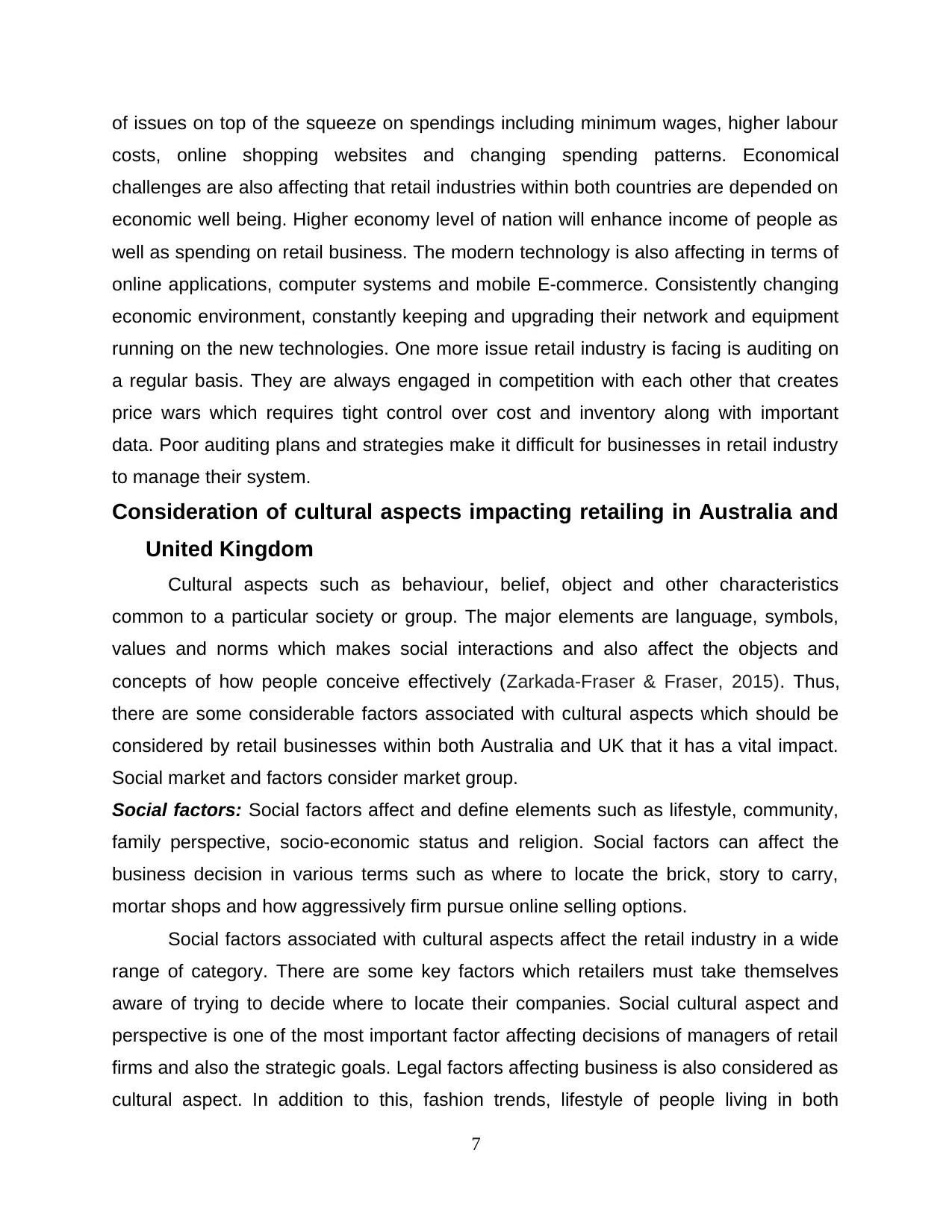
of issues on top of the squeeze on spendings including minimum wages, higher labour
costs, online shopping websites and changing spending patterns. Economical
challenges are also affecting that retail industries within both countries are depended on
economic well being. Higher economy level of nation will enhance income of people as
well as spending on retail business. The modern technology is also affecting in terms of
online applications, computer systems and mobile E-commerce. Consistently changing
economic environment, constantly keeping and upgrading their network and equipment
running on the new technologies. One more issue retail industry is facing is auditing on
a regular basis. They are always engaged in competition with each other that creates
price wars which requires tight control over cost and inventory along with important
data. Poor auditing plans and strategies make it difficult for businesses in retail industry
to manage their system.
Consideration of cultural aspects impacting retailing in Australia and
United Kingdom
Cultural aspects such as behaviour, belief, object and other characteristics
common to a particular society or group. The major elements are language, symbols,
values and norms which makes social interactions and also affect the objects and
concepts of how people conceive effectively (Zarkada-Fraser & Fraser, 2015). Thus,
there are some considerable factors associated with cultural aspects which should be
considered by retail businesses within both Australia and UK that it has a vital impact.
Social market and factors consider market group.
Social factors: Social factors affect and define elements such as lifestyle, community,
family perspective, socio-economic status and religion. Social factors can affect the
business decision in various terms such as where to locate the brick, story to carry,
mortar shops and how aggressively firm pursue online selling options.
Social factors associated with cultural aspects affect the retail industry in a wide
range of category. There are some key factors which retailers must take themselves
aware of trying to decide where to locate their companies. Social cultural aspect and
perspective is one of the most important factor affecting decisions of managers of retail
firms and also the strategic goals. Legal factors affecting business is also considered as
cultural aspect. In addition to this, fashion trends, lifestyle of people living in both
7
costs, online shopping websites and changing spending patterns. Economical
challenges are also affecting that retail industries within both countries are depended on
economic well being. Higher economy level of nation will enhance income of people as
well as spending on retail business. The modern technology is also affecting in terms of
online applications, computer systems and mobile E-commerce. Consistently changing
economic environment, constantly keeping and upgrading their network and equipment
running on the new technologies. One more issue retail industry is facing is auditing on
a regular basis. They are always engaged in competition with each other that creates
price wars which requires tight control over cost and inventory along with important
data. Poor auditing plans and strategies make it difficult for businesses in retail industry
to manage their system.
Consideration of cultural aspects impacting retailing in Australia and
United Kingdom
Cultural aspects such as behaviour, belief, object and other characteristics
common to a particular society or group. The major elements are language, symbols,
values and norms which makes social interactions and also affect the objects and
concepts of how people conceive effectively (Zarkada-Fraser & Fraser, 2015). Thus,
there are some considerable factors associated with cultural aspects which should be
considered by retail businesses within both Australia and UK that it has a vital impact.
Social market and factors consider market group.
Social factors: Social factors affect and define elements such as lifestyle, community,
family perspective, socio-economic status and religion. Social factors can affect the
business decision in various terms such as where to locate the brick, story to carry,
mortar shops and how aggressively firm pursue online selling options.
Social factors associated with cultural aspects affect the retail industry in a wide
range of category. There are some key factors which retailers must take themselves
aware of trying to decide where to locate their companies. Social cultural aspect and
perspective is one of the most important factor affecting decisions of managers of retail
firms and also the strategic goals. Legal factors affecting business is also considered as
cultural aspect. In addition to this, fashion trends, lifestyle of people living in both
7
⊘ This is a preview!⊘
Do you want full access?
Subscribe today to unlock all pages.

Trusted by 1+ million students worldwide
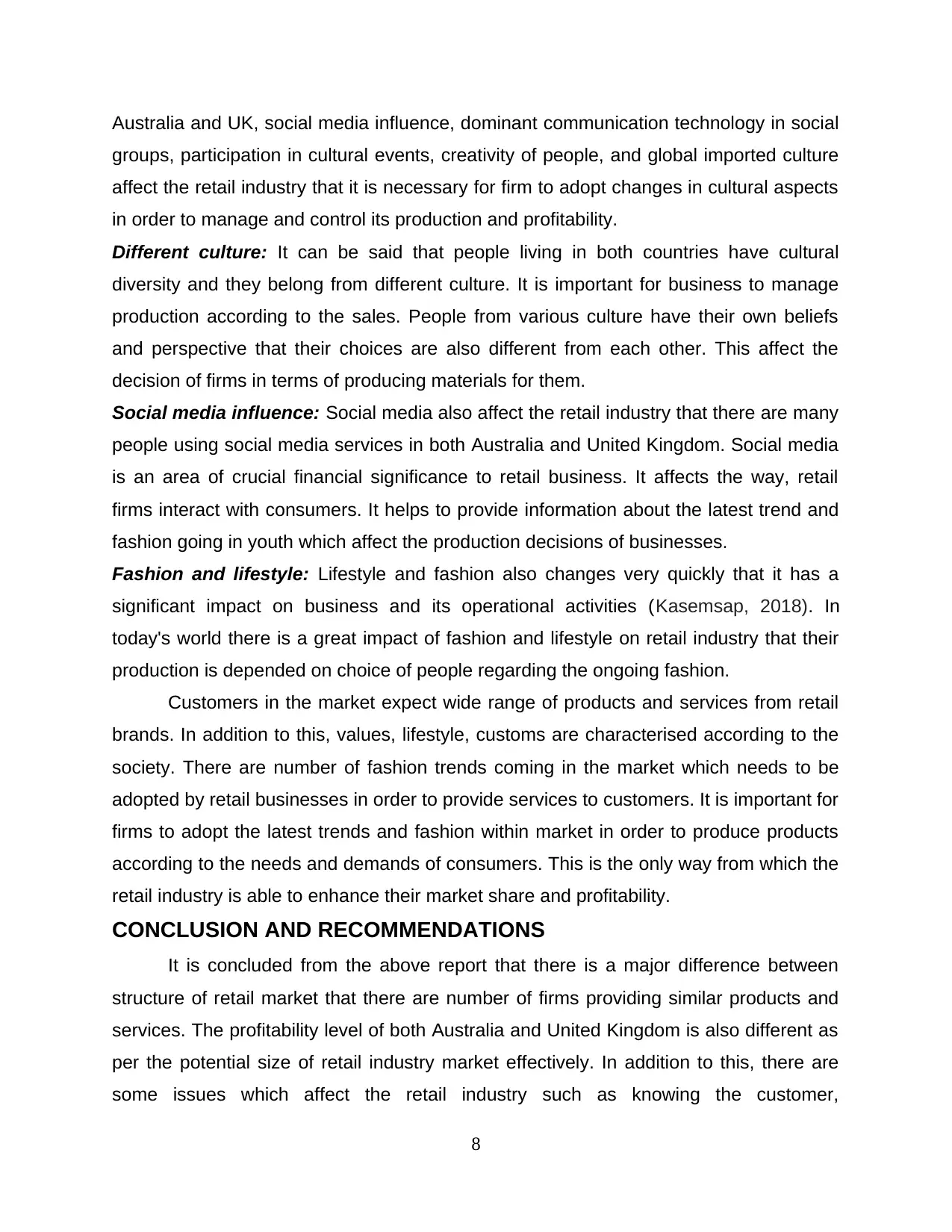
Australia and UK, social media influence, dominant communication technology in social
groups, participation in cultural events, creativity of people, and global imported culture
affect the retail industry that it is necessary for firm to adopt changes in cultural aspects
in order to manage and control its production and profitability.
Different culture: It can be said that people living in both countries have cultural
diversity and they belong from different culture. It is important for business to manage
production according to the sales. People from various culture have their own beliefs
and perspective that their choices are also different from each other. This affect the
decision of firms in terms of producing materials for them.
Social media influence: Social media also affect the retail industry that there are many
people using social media services in both Australia and United Kingdom. Social media
is an area of crucial financial significance to retail business. It affects the way, retail
firms interact with consumers. It helps to provide information about the latest trend and
fashion going in youth which affect the production decisions of businesses.
Fashion and lifestyle: Lifestyle and fashion also changes very quickly that it has a
significant impact on business and its operational activities (Kasemsap, 2018). In
today's world there is a great impact of fashion and lifestyle on retail industry that their
production is depended on choice of people regarding the ongoing fashion.
Customers in the market expect wide range of products and services from retail
brands. In addition to this, values, lifestyle, customs are characterised according to the
society. There are number of fashion trends coming in the market which needs to be
adopted by retail businesses in order to provide services to customers. It is important for
firms to adopt the latest trends and fashion within market in order to produce products
according to the needs and demands of consumers. This is the only way from which the
retail industry is able to enhance their market share and profitability.
CONCLUSION AND RECOMMENDATIONS
It is concluded from the above report that there is a major difference between
structure of retail market that there are number of firms providing similar products and
services. The profitability level of both Australia and United Kingdom is also different as
per the potential size of retail industry market effectively. In addition to this, there are
some issues which affect the retail industry such as knowing the customer,
8
groups, participation in cultural events, creativity of people, and global imported culture
affect the retail industry that it is necessary for firm to adopt changes in cultural aspects
in order to manage and control its production and profitability.
Different culture: It can be said that people living in both countries have cultural
diversity and they belong from different culture. It is important for business to manage
production according to the sales. People from various culture have their own beliefs
and perspective that their choices are also different from each other. This affect the
decision of firms in terms of producing materials for them.
Social media influence: Social media also affect the retail industry that there are many
people using social media services in both Australia and United Kingdom. Social media
is an area of crucial financial significance to retail business. It affects the way, retail
firms interact with consumers. It helps to provide information about the latest trend and
fashion going in youth which affect the production decisions of businesses.
Fashion and lifestyle: Lifestyle and fashion also changes very quickly that it has a
significant impact on business and its operational activities (Kasemsap, 2018). In
today's world there is a great impact of fashion and lifestyle on retail industry that their
production is depended on choice of people regarding the ongoing fashion.
Customers in the market expect wide range of products and services from retail
brands. In addition to this, values, lifestyle, customs are characterised according to the
society. There are number of fashion trends coming in the market which needs to be
adopted by retail businesses in order to provide services to customers. It is important for
firms to adopt the latest trends and fashion within market in order to produce products
according to the needs and demands of consumers. This is the only way from which the
retail industry is able to enhance their market share and profitability.
CONCLUSION AND RECOMMENDATIONS
It is concluded from the above report that there is a major difference between
structure of retail market that there are number of firms providing similar products and
services. The profitability level of both Australia and United Kingdom is also different as
per the potential size of retail industry market effectively. In addition to this, there are
some issues which affect the retail industry such as knowing the customer,
8
Paraphrase This Document
Need a fresh take? Get an instant paraphrase of this document with our AI Paraphraser
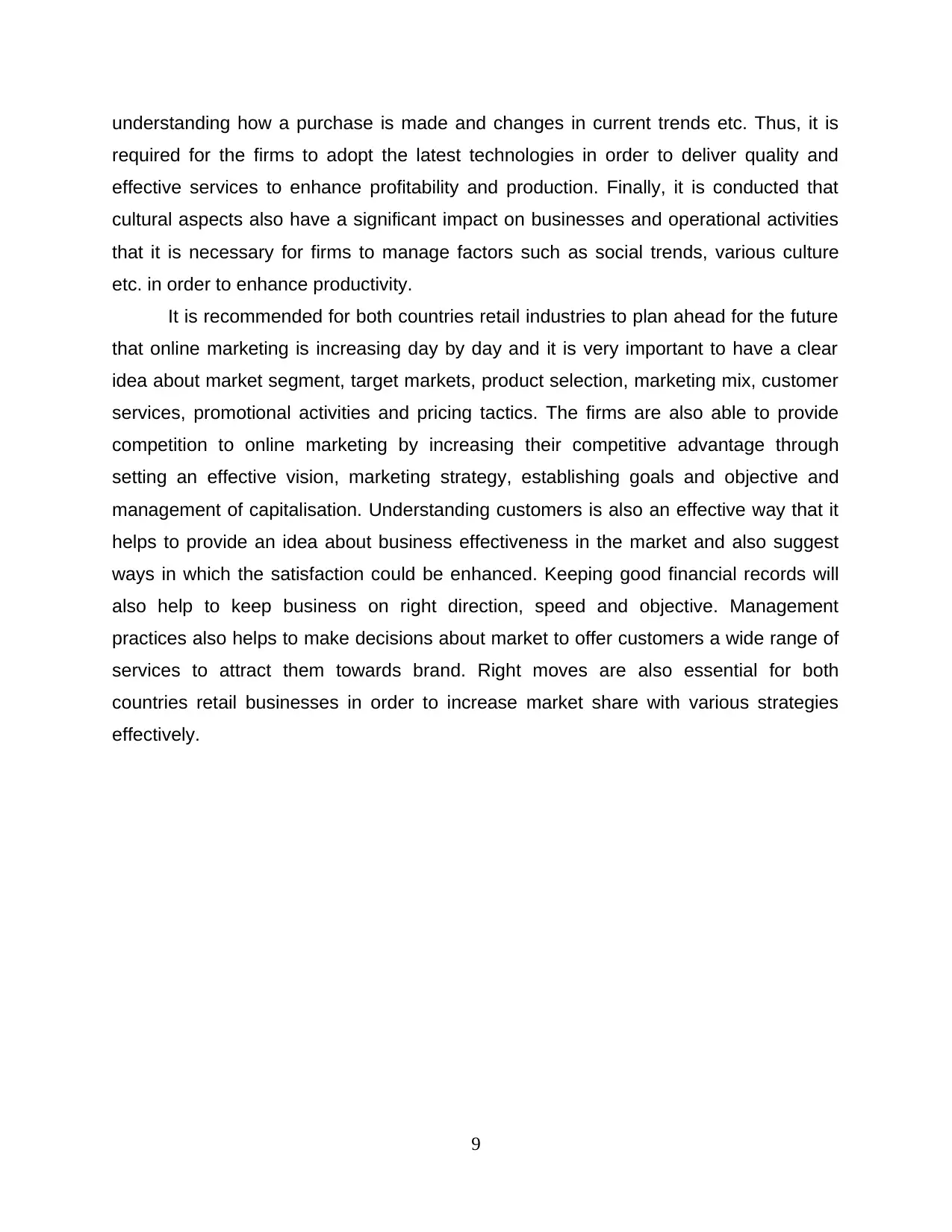
understanding how a purchase is made and changes in current trends etc. Thus, it is
required for the firms to adopt the latest technologies in order to deliver quality and
effective services to enhance profitability and production. Finally, it is conducted that
cultural aspects also have a significant impact on businesses and operational activities
that it is necessary for firms to manage factors such as social trends, various culture
etc. in order to enhance productivity.
It is recommended for both countries retail industries to plan ahead for the future
that online marketing is increasing day by day and it is very important to have a clear
idea about market segment, target markets, product selection, marketing mix, customer
services, promotional activities and pricing tactics. The firms are also able to provide
competition to online marketing by increasing their competitive advantage through
setting an effective vision, marketing strategy, establishing goals and objective and
management of capitalisation. Understanding customers is also an effective way that it
helps to provide an idea about business effectiveness in the market and also suggest
ways in which the satisfaction could be enhanced. Keeping good financial records will
also help to keep business on right direction, speed and objective. Management
practices also helps to make decisions about market to offer customers a wide range of
services to attract them towards brand. Right moves are also essential for both
countries retail businesses in order to increase market share with various strategies
effectively.
9
required for the firms to adopt the latest technologies in order to deliver quality and
effective services to enhance profitability and production. Finally, it is conducted that
cultural aspects also have a significant impact on businesses and operational activities
that it is necessary for firms to manage factors such as social trends, various culture
etc. in order to enhance productivity.
It is recommended for both countries retail industries to plan ahead for the future
that online marketing is increasing day by day and it is very important to have a clear
idea about market segment, target markets, product selection, marketing mix, customer
services, promotional activities and pricing tactics. The firms are also able to provide
competition to online marketing by increasing their competitive advantage through
setting an effective vision, marketing strategy, establishing goals and objective and
management of capitalisation. Understanding customers is also an effective way that it
helps to provide an idea about business effectiveness in the market and also suggest
ways in which the satisfaction could be enhanced. Keeping good financial records will
also help to keep business on right direction, speed and objective. Management
practices also helps to make decisions about market to offer customers a wide range of
services to attract them towards brand. Right moves are also essential for both
countries retail businesses in order to increase market share with various strategies
effectively.
9
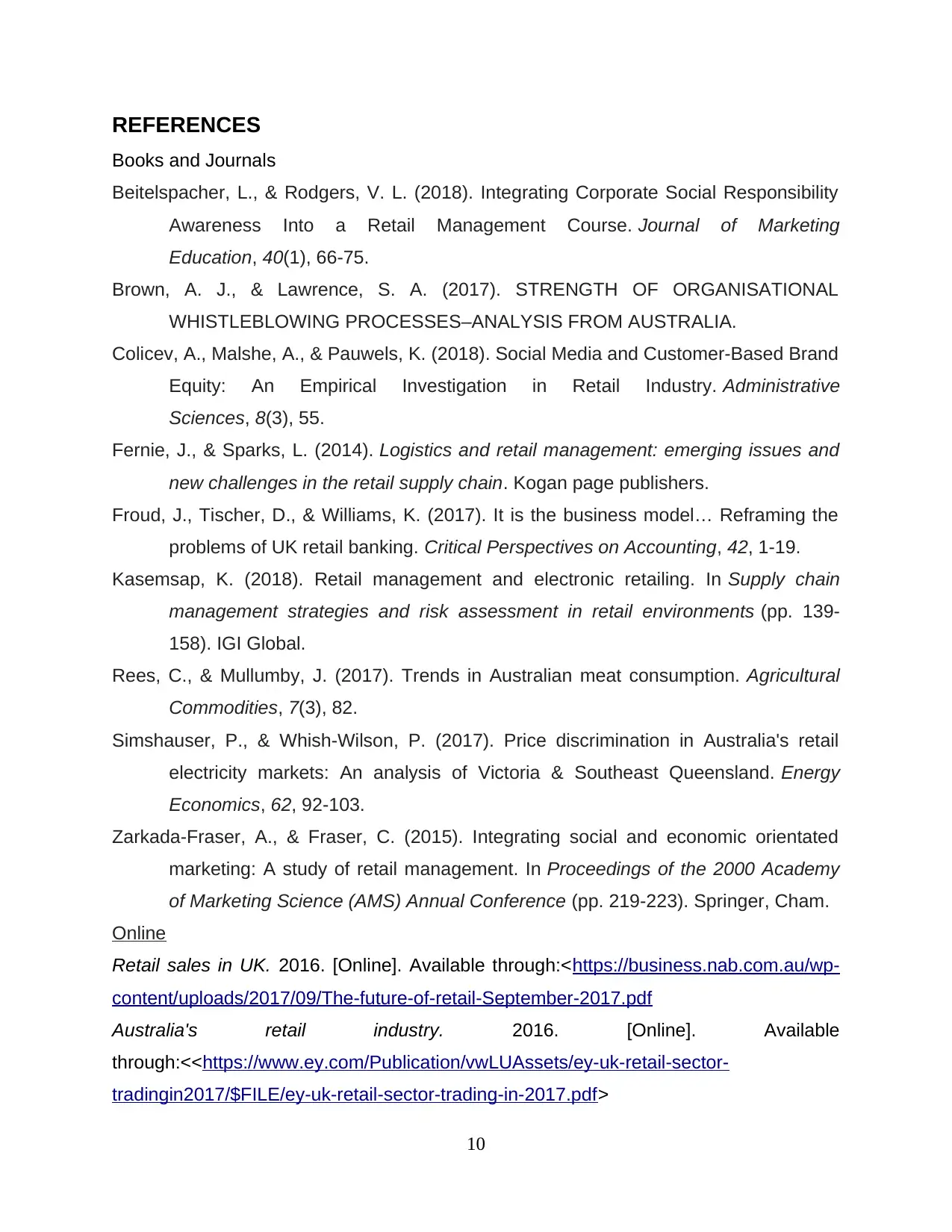
REFERENCES
Books and Journals
Beitelspacher, L., & Rodgers, V. L. (2018). Integrating Corporate Social Responsibility
Awareness Into a Retail Management Course. Journal of Marketing
Education, 40(1), 66-75.
Brown, A. J., & Lawrence, S. A. (2017). STRENGTH OF ORGANISATIONAL
WHISTLEBLOWING PROCESSES–ANALYSIS FROM AUSTRALIA.
Colicev, A., Malshe, A., & Pauwels, K. (2018). Social Media and Customer-Based Brand
Equity: An Empirical Investigation in Retail Industry. Administrative
Sciences, 8(3), 55.
Fernie, J., & Sparks, L. (2014). Logistics and retail management: emerging issues and
new challenges in the retail supply chain. Kogan page publishers.
Froud, J., Tischer, D., & Williams, K. (2017). It is the business model… Reframing the
problems of UK retail banking. Critical Perspectives on Accounting, 42, 1-19.
Kasemsap, K. (2018). Retail management and electronic retailing. In Supply chain
management strategies and risk assessment in retail environments (pp. 139-
158). IGI Global.
Rees, C., & Mullumby, J. (2017). Trends in Australian meat consumption. Agricultural
Commodities, 7(3), 82.
Simshauser, P., & Whish-Wilson, P. (2017). Price discrimination in Australia's retail
electricity markets: An analysis of Victoria & Southeast Queensland. Energy
Economics, 62, 92-103.
Zarkada-Fraser, A., & Fraser, C. (2015). Integrating social and economic orientated
marketing: A study of retail management. In Proceedings of the 2000 Academy
of Marketing Science (AMS) Annual Conference (pp. 219-223). Springer, Cham.
Online
Retail sales in UK. 2016. [Online]. Available through:<https://business.nab.com.au/wp-
content/uploads/2017/09/The-future-of-retail-September-2017.pdf
Australia's retail industry. 2016. [Online]. Available
through:<<https://www.ey.com/Publication/vwLUAssets/ey-uk-retail-sector-
tradingin2017/$FILE/ey-uk-retail-sector-trading-in-2017.pdf>
10
Books and Journals
Beitelspacher, L., & Rodgers, V. L. (2018). Integrating Corporate Social Responsibility
Awareness Into a Retail Management Course. Journal of Marketing
Education, 40(1), 66-75.
Brown, A. J., & Lawrence, S. A. (2017). STRENGTH OF ORGANISATIONAL
WHISTLEBLOWING PROCESSES–ANALYSIS FROM AUSTRALIA.
Colicev, A., Malshe, A., & Pauwels, K. (2018). Social Media and Customer-Based Brand
Equity: An Empirical Investigation in Retail Industry. Administrative
Sciences, 8(3), 55.
Fernie, J., & Sparks, L. (2014). Logistics and retail management: emerging issues and
new challenges in the retail supply chain. Kogan page publishers.
Froud, J., Tischer, D., & Williams, K. (2017). It is the business model… Reframing the
problems of UK retail banking. Critical Perspectives on Accounting, 42, 1-19.
Kasemsap, K. (2018). Retail management and electronic retailing. In Supply chain
management strategies and risk assessment in retail environments (pp. 139-
158). IGI Global.
Rees, C., & Mullumby, J. (2017). Trends in Australian meat consumption. Agricultural
Commodities, 7(3), 82.
Simshauser, P., & Whish-Wilson, P. (2017). Price discrimination in Australia's retail
electricity markets: An analysis of Victoria & Southeast Queensland. Energy
Economics, 62, 92-103.
Zarkada-Fraser, A., & Fraser, C. (2015). Integrating social and economic orientated
marketing: A study of retail management. In Proceedings of the 2000 Academy
of Marketing Science (AMS) Annual Conference (pp. 219-223). Springer, Cham.
Online
Retail sales in UK. 2016. [Online]. Available through:<https://business.nab.com.au/wp-
content/uploads/2017/09/The-future-of-retail-September-2017.pdf
Australia's retail industry. 2016. [Online]. Available
through:<<https://www.ey.com/Publication/vwLUAssets/ey-uk-retail-sector-
tradingin2017/$FILE/ey-uk-retail-sector-trading-in-2017.pdf>
10
⊘ This is a preview!⊘
Do you want full access?
Subscribe today to unlock all pages.

Trusted by 1+ million students worldwide
1 out of 13
Related Documents
Your All-in-One AI-Powered Toolkit for Academic Success.
+13062052269
info@desklib.com
Available 24*7 on WhatsApp / Email
![[object Object]](/_next/static/media/star-bottom.7253800d.svg)
Unlock your academic potential
Copyright © 2020–2025 A2Z Services. All Rights Reserved. Developed and managed by ZUCOL.





